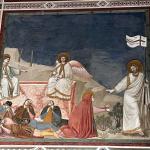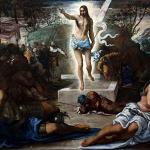In his essay, “White Mythology,” Derrida offers this critical discussion of Aristotle: “This is the difference between animals and man: according to Aristotle both can emit indivisible sounds, but only man can make of them a letter . . . Aristotle does not analyze this difference; he interprets it by teleological retrospection. No internal characteristic distinguishes the atom of animal sound and the letter. Thus, it is only on the basis of the signifying phonic composition, on the basis of meaning and reference, that the human voice should be distinguished from the call of an animal. Meaning and reference: that is, the possibility of signifying by means of a noun. What is proper to nouns is to signify something, an independent being identical to itself, conceived as such. It is at this point that the theory of the name, such as it is implied by the concept of metaphor, is articulated with ontology. Aside from the classical and dogmatically affirmed limit between the animal without logos and man as zoon logon ekhon, what appears here is a certain systematic indissociability of the value of metaphor and the metaphysical chain holding together the values of discourse, voice, noun, signification, meaning, imitative representation, resemblance; or, in order to reduce what these translations import or deport, the values of logos, phone semantike, semainein, onoma, mimesis, homoiosis . . . .
“Mimesis is never without the theoretical perception of resemblance or similarity, that is, of that which will always be posited as the condition for metaphor. Homoiosis is not only constitutive of the value of truth (aletheia) which governs the entire chain; it is that without which the metaphorical operation is impossible: ‘To produce a good metaphor is to see a likeness’. The condition for metaphor (for good and true metaphor) is the condition for truth.”
Christopher Norris comments that, although this is not a straightforward affirmation of Aristotle’s position, it is “equally unjustified – here as elsewhere in Derrida’s work – to suppose that a deconstructive reading is a priori committed to the disarticulation of all truth-claims and the undoing of any theory (such as Aristotle’s) predicated on values of truth, reason, logical form, conceptual adequacy, empirical warrant, and so forth.”
To read Derrida in this fashion, Norris argues, ignores the purpose of the essay, which involves a “critical questioning of such values in a manner that itself maintains the highest standards of analytical consistency and rigour while not taking anything for granted in the way that those standards have hitherto or traditionally been applied. In other words deconstruction carries on the critique of established (commonsense, naturalised, or consensus-based) modes of perception or conceptualization which has characterized philosophy in the tradition from Aristotle to Descartes, Kant, and Husserl. No doubt it does so through a method of analysis – the rhetorical close-reading of various cardinal texts in that tradition – which departs very markedly from other, more conventional ideas of what constitutes a proper philosophical critique. No doubt it raises issues – about truth, representation, the extent to which metaphors can be ‘adequately’ conceptualized or intuitions brought under ‘adequate’ concepts – that have provoked consternation (or outright dismissal) among many philosophers. Yet the above passage should at least give pause to anyone who is tempted to regard ‘White Mythology’ as a mere exercise in ‘textualist’ mystification or an argument devoted to such simplified (pseudo-deconstructive) slogans as that ‘all concepts are metaphors,’ ‘reality just a fictive or rhetorical construct,’ or ‘truth just a product of the will-to-power vested in figural language.’”
Further, “Derrida is not for one moment suggesting that just because Aristotle has recourse to metaphor – or to metaphor-related notions like resemblance, mimesis, the ‘perception of similarity’, etc. – at crucial points in his argument, therefore his entire ontology and epistemology (along with his logic, metaphysics, and conception of enquiry in the natural or physical sciences) comes down to nothing more than a series of figural tropes and substitutions, indifferent with regard to their truth-content or capacity for conceptual elucidation and critique. Nor is he committed to the absurd view that truth and reality just are what we make of them according to this or that favoured rhetoric, language-game, discourse, vocabulary, or whatever.”
Derrida does challenge the way metaphor has been viewed in philosophy: “metaphor . . . is determined by philosophy as a provisional loss of meaning, an economy of the proper without irreparable damage, a certainly inevitable detour, but also a history with its sights set on, and within the horizon of, the circular reappropriation of literal, proper meaning.” And he highlights the paradox that philosophy depends on the very metaphorical modes of language that it subordinates: “the philosophical evaluation of metaphor has always been ambiguous: metaphor is dangerous and foreign as concerns intuition (vision or contact), concept (the grasping or proper presence of the signified), and consciousness (proximity or self-presence); but it is in complicity with what it endangers, is necessary to it in the extent to which the de-tour is a re-turn guided by the function of resemblance (mimesis or homoiosis), under the law of the same.”
But if this is taken to imply a “metaphorization” of philosophy, Norris argues, “there could then be no accounting for that other (often strongly counter-intuitive) process of conceptual ‘rectification’ that enables scientific metaphors, models, and analogies to bring about genuine advances in our knowledge of physical objects, processes, and events.”














